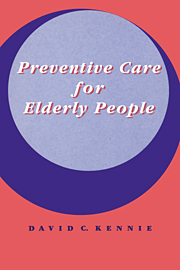Book contents
- Frontmatter
- Contents
- Acknowledgements
- 1 An overall perspective
- 2 What is health in old age?
- 3 The goals of health promotion for elderly people
- 4 A task for everyone
- 5 Critique of strategies
- 6 Cancer prevention
- 7 The prevention of non-cancerous health problems
- 8 Enhancing functional status
- 9 Strengthening support systems
- 10 Summary of problems and strategies
- 11 Tailoring strategies to individuals
- 12 Targeting, screening and surveillance in primary care
- 13 Practical aspects of implementation
- 14 The costs of preventive care and health promotion
- Index
11 - Tailoring strategies to individuals
Published online by Cambridge University Press: 15 October 2009
- Frontmatter
- Contents
- Acknowledgements
- 1 An overall perspective
- 2 What is health in old age?
- 3 The goals of health promotion for elderly people
- 4 A task for everyone
- 5 Critique of strategies
- 6 Cancer prevention
- 7 The prevention of non-cancerous health problems
- 8 Enhancing functional status
- 9 Strengthening support systems
- 10 Summary of problems and strategies
- 11 Tailoring strategies to individuals
- 12 Targeting, screening and surveillance in primary care
- 13 Practical aspects of implementation
- 14 The costs of preventive care and health promotion
- Index
Summary
When the specific strategies outlined in the previous chapters are applied, they should be tailored to meet the needs and wishes of elderly individuals according to the following broad principles.
Time the intervention precisely
There is a ‘critical intervention time’ or ‘window’ during which various types of support should be provided. A patient's functional status may deteriorate slightly for several years, with the impairment being noticeable only to the family. A crisis may then develop during which the situation deteriorates rapidly. If support is added too late, institutionalisation is often the outcome. If it is provided too early, however, it merely fosters dependency, wastes resources, is costly to society, and is considered by many elderly people to be an intrusion on their privacy.
Intervention of any sort, whether it be the relocation of an elderly person into specialised housing or the provision of a community service, must, therefore, be timed precisely if it is to be effective and to avoid detriment. Many caring professionals, however, will be tempted to prescribe unnecessary supports for the elderly during the early phase of functional decline because of their own anxieties and pressure from anxious family members. There is, for example, evidence from the UK that a significant proportion of social service ‘home help’, ‘meals on wheels’ and home aid allocation is given to those elderly people who are relatively fit and who are not strictly in need of the service.
- Type
- Chapter
- Information
- Preventive Care for Elderly People , pp. 265 - 270Publisher: Cambridge University PressPrint publication year: 1993



